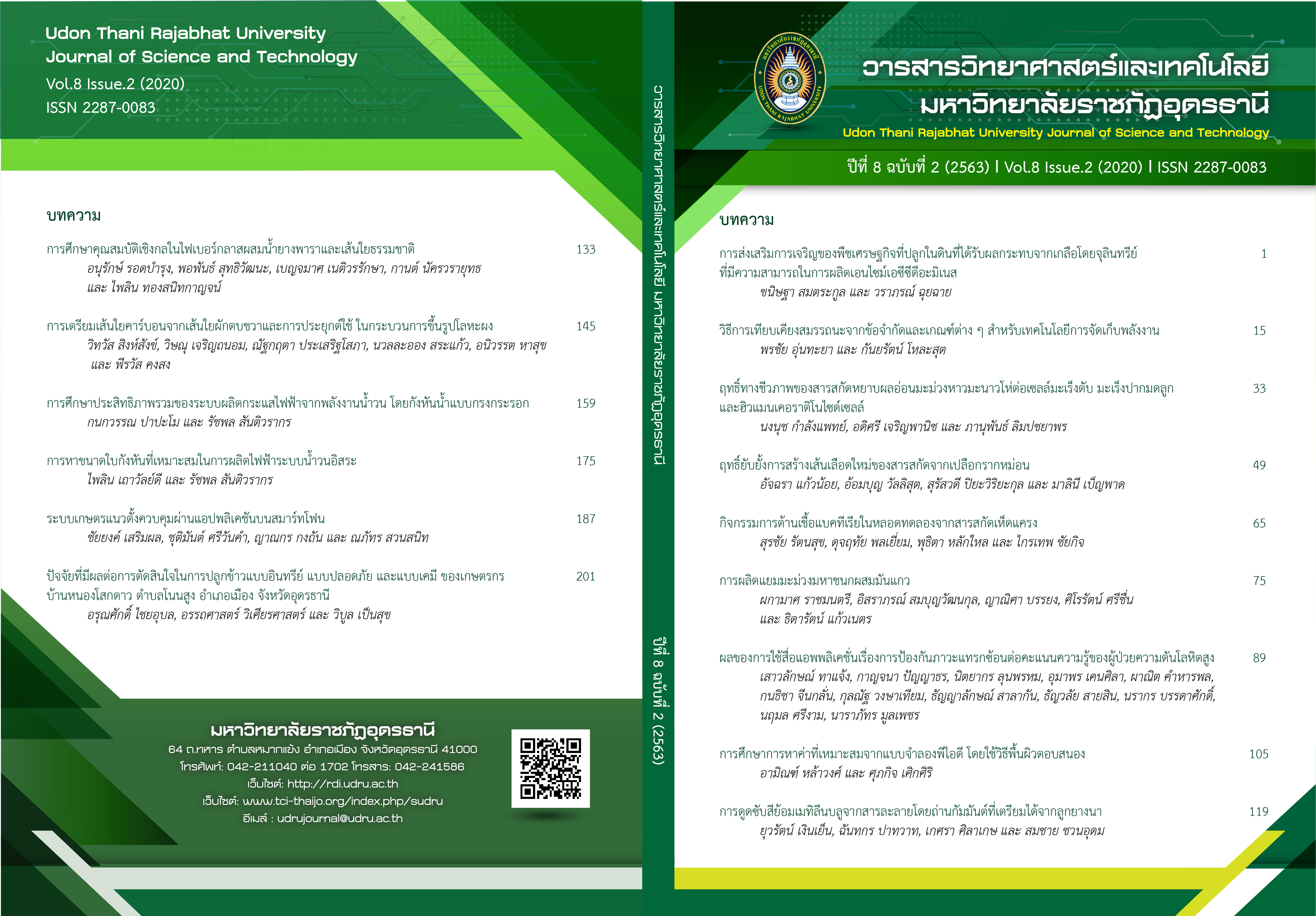ฤทธิ์ทางชีวภาพของสารสกัดหยาบผลอ่อนมะม่วงหาวมะนาวโห่ต่อเซลล์มะเร็งตับ มะเร็งปากมดลูกและฮิวแมนเคอราติโนไซด์เซลล์
Main Article Content
บทคัดย่อ
มะม่วงหาวมะนาวโห่เป็นผลไม้พื้นบ้านของคนไทยที่ให้ความสนใจมากขึ้นเนื่องจากมีประโยชน์ต่อร่างกายและสามารถนำมารักษาโรคได้ เพื่อให้การมะม่วงหาวมะนาวโห่มาใช้ในทางการแพทย์อย่างมีประสิทธิภาพมากขึ้นจึงได้มีการศึกษาฤทธิ์ทางชีวภาพของสารสกัดหยาบผลอ่อนของมะม่วงหาวมะนาวโห่ในชั้นน้ำต่อเซลล์ HepG2, HeLa และ HaCaT กิจกรรมการวิจัยสารต้านอนุมูลอิสระถูกกำหนดโดย 1,1-diphenyl-2-picrylhydrazyl (DPPH) assay ผลการวิจัยพบว่า IC50 เท่ากับ 88.05 ± 0.06 µg/mL และ 0.25 ± 0.28 mg/mL ตามลำดับ และงานวิจัยนี้ยังได้ทำการทดสอบฤทธิ์ของ มะม่วงหาวมะนาวโห่ที่ความเข้มข้น 0, 0.01, 0.05, 0.10, 0.50 และ 1.00 mg/mL กับเซลล์ทั้ง 3 ชนิด เป็นเวลา 24, 48 ชั่วโมง จากนั้นหาอัตราการรอดชีวิตของเซลล์โดยใช้การทดสอบด้วยวิธี MTT assay พบว่าเซลล์ HepG2 0.01-1.00 mg/mL ทุกช่วงเวลามีผลต่อการรอดชีวิตของเซลล์ลดลงอย่างมีนัยสำคัญทางสถิติ (P <0.05) เมื่อเปรียบเทียบกับกลุ่มควบคุม สำหรับในการทดสอบกับเซลล์ Hela พบว่าความเข้มข้น 0.05-1.00 mg/mL เป็นเวลา 48 ชั่วโมง มีอัตราการรอดชีวิตของเซลล์ลดลงอย่างมีนัยสำคัญทางสถิติ (P <0.05) ส่วนเซลล์ HaCaT พบว่าความเข้มข้น 0.01 mg/mL มีอัตราการรอดชีวิตต่ำกว่า 50% เมื่อเปรียบเทียบกับการควบคุมอย่างมีนัยสำคัญทางสถิติ (P <0.05) และพบว่าสารสกัดหยาบผลอ่อนของมะม่วงหาวมะนาวโห่มีการตอบสนองความเป็นพิษต่อเซลล์ต่างกัน ซึ่งอาจนำไปใช้ประโยชน์ในการพัฒนาสารสำคัญเพื่อใช้ในการป้องกันโรคต่างๆ รวมทั้งโรคมะเร็งต่อไป
Article Details
เอกสารอ้างอิง
เกษตรดิจิทัล. (2020). ข้อมูลพันธ์ไม้ระบบฐานข้อมูลดิจิทัล. สืบค้นเมื่อวันที่ 1 ตุลาคม 2560, จาก https://data.addrun.org/ plant/archives/321-carissa-carandas-l.
เกสรี กลิ่นสุคนธ์. (2560). ระยะการสุกของผลมะม่วงหาวมะนาวโห่ต่อการต้านอนุมูลอิสระและการยับยั้งเอนไซม์แอลฟากลูโคซิเดส. ในการประชุมทางวิชาการของมหาวิทยาลัย เกษตรศาสตร์ ครั้งที่ 55. วันที่ 31 มกราคม 2560-3 กุมภาพันธ์ 2560. มหาวิทยาลัย เกษตรศาสตร์, กรุงเทพมหานคร. หน้า 841-848.
ณพัฐอร บัวฉุน. (2561). ฤทธิ์ต้านอนุมูลอิสระและสารประกอบฟีนอลิกของเมล็ดและเนื้อมะม่วง ไม่รู้โห่. วารสารวิจัยและพัฒนาวไลยอลงกรณ์ ในพระบรมราชูปถัมภ์, 13(2), 53-63.
เรณู เวชรัชต์พิมลม (2540). การเพาะเลี้ยงเซลล์สัตว์. ภาควิชาชีววิทยา คณะวิทยาศาสตร์ มหาวิทยาลัยศิลปากร.
วชิราภรณ์ ผิวล่อง, สุรศักดิ์สัจจบุตร, ศิริลักษณ์ สิงห์เพชร และ จารุรัตน์ เอี่ยมศิริ. (2556). อิทธิพลของระยะเวลาสุกต่อสารออกฤทธิ์ทางชีวภาพของมะม่วงหาวมะนาวโห่. วารสารวิทยาศาสตร์เกษตร, 44(ฉบับพิเศษ 2), 337-340.
สกุลกานต์ สิมลา, สุรศักดิ์ บุญแต่ง และ พัชรี สิริตระกูลศักดิ์. (2556). การประเมินปริมาณสารพฤกษเคมีบางประการและกิจกรรมของสารต้านอนุมูลอิสระใน Carissa carandas Linn. แก่นเกษตร, 41(ฉบับพิเศษ 1), 602-606.
Begum, S., Syed, S. A., Siddiqui, B. S., Sattar, S. A., & Choudhary M. I. (2013). Carandinol: First isohopane triterpene from the leaves of Carissa carandas L. and its cytotoxicity against cancer cell lines. Phytochemistry Letters, 6, 91-95.
Bhaskar V. H., & Balakrishnan N. (2009). Analgesic, Anti-Inflammatory and Antipyretic Activities of Pergularia daemia and Carissa carandas, DARU. Journal of Pharmaceutical Sciences, 17(3), 168-174.
David, M., & Karekalammanavar, G. (2015). Spectrographic analysis and in vitro study of antibacterial, anticancer activity of aqueous ethanolic fruit extract of Carissa carandas L. Journal of Advanced Scientific Research, 6(3), 10-13.
Gupta, P., Bhatnagar, I., Kim S. K., Verma, A. K., & Shatma, A. (2014). In-vitro cancer cell cytotoxicity and alpha amylase inhibition effect of seven tropical fruit residues. Asian Pac Journal of Trop Biomed, 4(2), 665-671.
Hegde, K., & Joshi, A. B. (2009). Hepatoprotective effect of carissa carandas Linn. root extract against CCl4 and paracetamol induced hepatic oxidative stress. Indian Journal of Experimental Biology, 47(8), 660-667.
Itankar, P. R., Lokhande, S. J., Verma, P. R., Arora, S. K., Sahu, R. A., & Patil, A. T. (2011). Antidiabetic potential of unripe Carissa carandas Linn. Fruit extract. Journal of Ethnopharmacology, 135, 430-433.
Kubola, J., Siriamornpun, S., & Meeso, N. (2011). Phytochemicals, vitamin C and sugar content of Thai wild fruits. Food Chemistry, 126, 972-981.
Kumar, S., Gupta, P., & Gupta, V. K. L. (2013). A critical review on Karamarda (Carissa carandas Linn.) International Journal of Pharmaceutical & Biological Archive, 4(4), 637-642.
Pewlong, W., Sajjabut, S., Singphet, S., & Eamsiri, J. (2013). Influence of fruit ripening stages on the bioactive compounds of carissa carandas. Agriculture Journal, 41, 602-606.
Rubinstein, L. V., Shoemaker, R., Paull, K. D., Simon, R. M., Tosini, S., & Skehan, P. (1990). Comparison of in vitro anticancer-drug-screening data generated with a tetrazolium assay versus a protein assay against a diverse panel of human tumor cell lines. Journal of the National Cancer Institute, 82(13), 1113-1118.
Sarma, A., Sarmah, P., Kashyap, D., Dutta, S., & Mahanta, M. (2015). Antioxidant activity and nutraceutical property of the fruits of an Ethano-Medicinal Plant : Carissa carandas L. found in Brahmaputra Valley Agro-Climatic Condition. Journal of Pharmaceutical Sciences and Research, 7(2), 55-57.
Sabira, B., Saqib, A. S., Bina, S. S. Samina, A. S. M., & Iqbal, C. (2013). The evaluation of some phytochemical content and antioxidant activity in Carissa carandas L. Agriculture Journal, 41(Suppl), 602-606.
Senthilraja, P., & Kathiresan, K. (2015). In vitro cytotoxicity MTT assay in Vero, HepG2 and MCF -7 cell lines study of Marine Yeast. Journal of Applied Pharmaceutical Science, 5(03), 080-084.
Sharma, A., Reddy, G. D., Kaushik, A., Shanker, K., Tiwari, R. K., Mukherjee, A., & Rao, C. V. (2007) Analgesic and Anti-inflammatory Activity of Carissa carandas L. Fruits and Microstylis wallichii Lindl Tubers. Natural Product Sciences, 13(1), 6-10.
SimLa, S., Boontang, S., & Siritrakulsak, P. (2013). The evaluation of some
Phytochemical content and Antioxidant activity in Carissa carandas L. Agriculture Journal, 44(2), 337-340.
Sulaiman, S. F., Teng, W. S., Leong, O. K., Yusof, S. R., & Muhammad, T. S. T. (n.d.). Anticancer study of Carissa carandas extracts. Retrieved May 16, 2014 from http://goo.gl/W2WjSG.
Wachiraporn, P., Surasak, S., Jaruratana, E., & Sirilak, C. (2014). Evaluation of Antioxidant activities, Anthocyanins, Total Phenolic Content, Vitamin C Content and Cytotoxicity of Carissa carandas Linn. CMUJ NS Special Issue on Food and Applied Bioscience, 13(1), 509-517.


